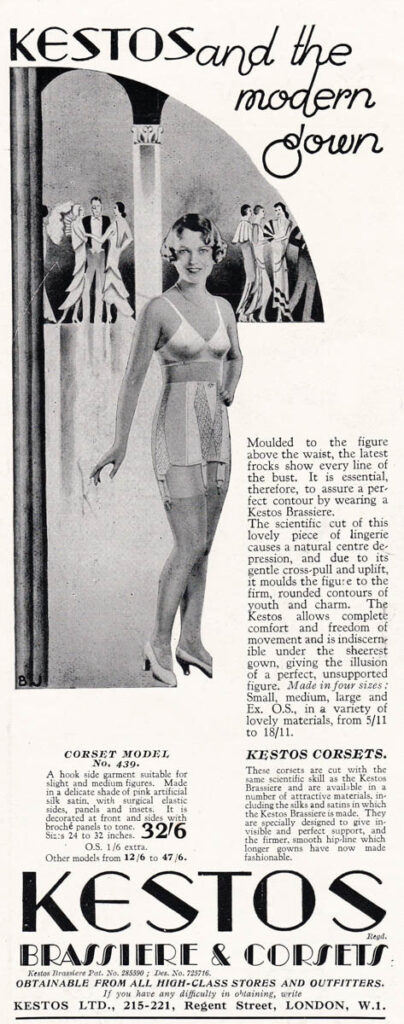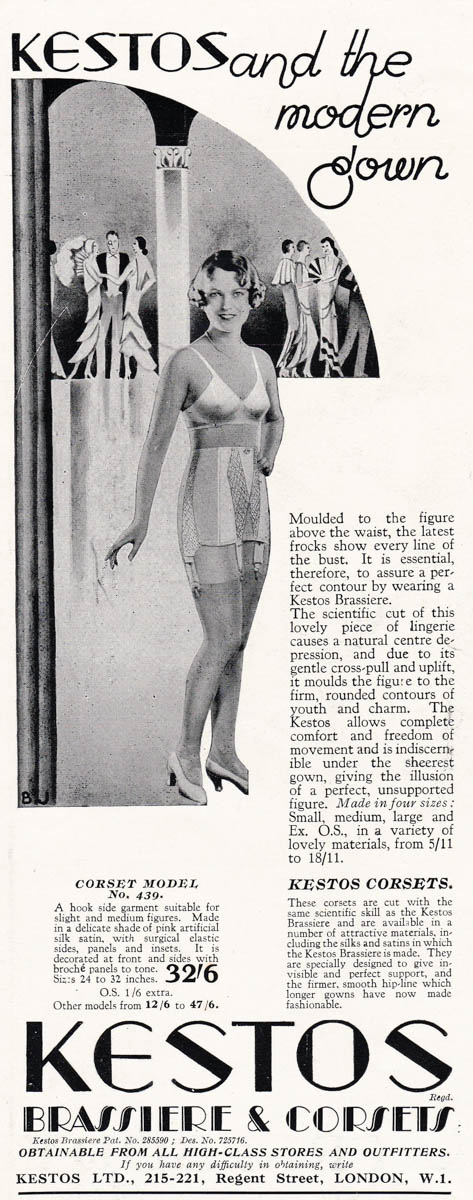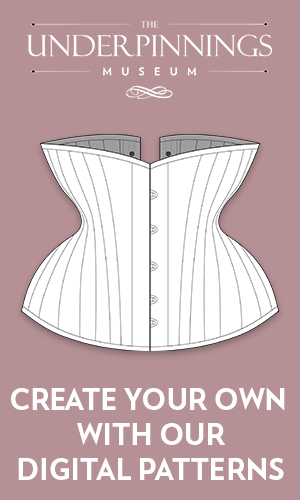Date: c. 1930s
Origin: Great Britain
Brand: Kestos
This circa 1930s Kestos advertisement depicts a smiling young woman with waved, bobbed hair, donning a two-cupped brassiere, a corset paired with stockings, and a fashionably high-heel. Behind her stretches an Art-Deco-style illustration showcasing men and women socializing in an elegant building framed by neoclassical columns. The popularity of this neoclassical revival is evident in fashion imagery of the time, such as Madeleine Vionnet’s “Bas Relief frieze dress” (1931), photographed by George Hoyningen-Heune. The women depicted in this illustration also wear gowns resembling prominent couture houses of this era, such as Vionnet, positioning Kestos as being in line with prevailing fashionable ideals.
This youthful, boyish style of the previous decade demanded a pre-pubescent figure, provoking a flurry of use of adjectives such as “slender,” “sleek,” and “youthful” on the pages of fashion magazines. As the 1920s turned into the 1930s, top designers promoted floor length dresses made of smooth textiles, such as satin and charmeuse, often in shades of ivory and peach. Garments were cut on the bias, and moulded to the body, falling into soft drapes. Though curves had returned to fashion, slimming and contouring undergarments remained essential to achieving the desired smooth, controlled silhouette.
The main copy of the advertisement reads:
“Moulded to the figure above the waist, the latest frocks show every line of the bust. It is essential, therefore, to assure a perfect contour by wearing a Kestos Brassiere. The scientific cut of this lovely piece of lingerie causes a natural centre depression, and due to its gentle cross-pull and uplift, it moulds the figure to the firm, rounded contours of youth and charm. The Kestos allows complete comfort and freedom of movement and is indiscernible under the sheerest gown, giving the illusion of a perfect, unsupported figure. Made in four sizes: Small, medium, large, and Ex. O.S., in a variety of lovely materials, from 5/11 to 18/11.”
This language emphasizes how the “modern gown” exposed the female form, requiring women to have the correct undergarments to achieve the desired smooth silhouette. The 1920s smooth-bust was replaced by the 1930s shaped bosom, achieved by use of newly structured brassieres. It also acknowledges the desire of women to remain active in their day to day lives, allowing “freedom of movement.” It also states that the brassiere went for between 5/11 (5 shillings and 11 pence) and 18/11 (18 shillings and 11 pence). It reads further:
“These corsets are cut with the same scientific skill as the Kestos Brassiere and are available in a number of attractive materials, including the silks and satins in which the Kestos Brassiere is made. They are specially designed to give invisible and perfect support, and the firmer, smooth hip-line which longer gowns have now made fashionable.”
This advertisement highlights the Kestos Corset model no. 439, described as a “hook side garment suitable for slight and medium figures,” reflecting the exclusionary nature of early twentieth-century sizing. The garment was available in a “delicate shade” of pink artificial silk satin, with decorative side panels designed “to tone,” in waist sizes ranging from 24 to 32 inches. Language throughout emphasizes the vogue for sheer, revealing dresses, describing how women should use Kestos undergarments to create the illusion of a flawless body underneath.
Towards the bottom of the graphic, prospective clients were assured that Kestos products were “obtainable from all high-class stores, and outfitters.” In smaller print, readers were directed, “if you have any difficulty obtaining, write Kestos LTD., 215-221, Regent Street, London, W.1.”
The Kestos lingerie brand was founded in 1925 in London by Rosamond Lilian Klin, remaining highly popular through the 1930s. It is best known for the ‘Kestos’ style bra, which, patented in 1926, is arguably one of the first commercially produced bra with separated cups. Alongside the iconic bar, the Kestos brand produced a full line of lingerie, foundation garments and even swimwear.
From the collection of Karolina Laskowska.
Many thanks to Liv Elniski for the object description and research.



